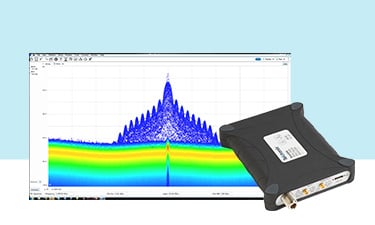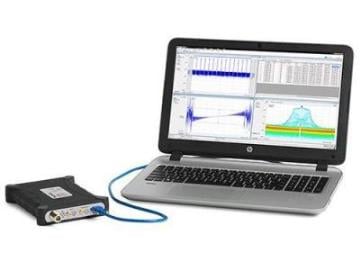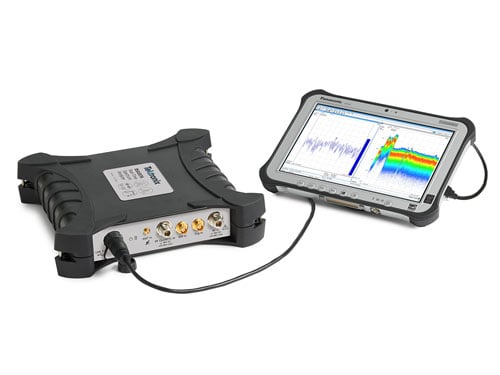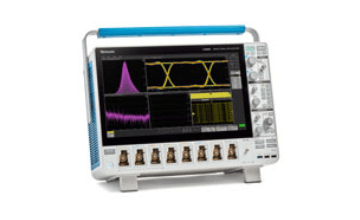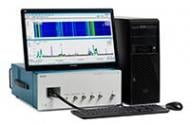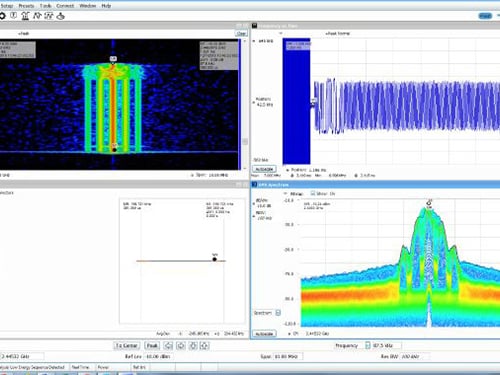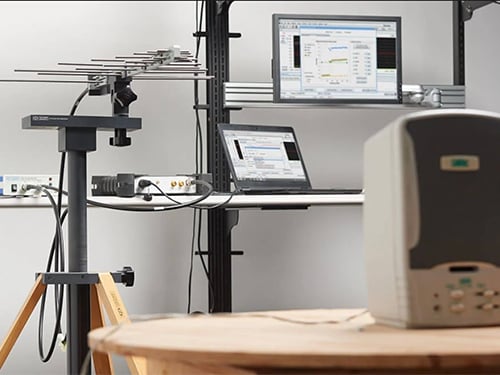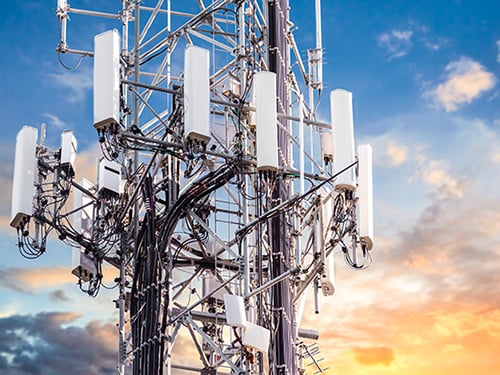Contact us
Live Chat with Tek representatives. Available 6:00 AM - 4:30 PM
Call us at
Available 6:00 AM – 5:00 PM (PST) Business Days
Download
Download Manuals, Datasheets, Software and more:
Feedback
Hiểu rõ về kiểm tra tần số vô tuyến: Chìa khóa thành công của hệ thống không dây
Kiểm tra tần số vô tuyến (RF) là quá trình đo lường và phân tích sóng điện từ được sử dụng để truyền tín hiệu trong nhiều ứng dụng khác nhau, từ truyền thông không dây và phát sóng cho đến hệ thống ra-đa và vệ tinh. Kiểm tra RF liên quan đến việc đánh giá hiệu suất, cường độ và chất lượng của các tín hiệu này để đảm bảo chúng đáp ứng các tiêu chuẩn và yêu cầu cụ thể. Điều này rất cần thiết cho việc phát triển, thẩm định và bảo trì các thành phần và hệ thống RF vì giúp xác định mọi vấn đề có thể ảnh hưởng đến chức năng và độ tin cậy của hệ thống cảm biến và truyền thông không dây. Ngoài ra, kiểm tra RF đảm bảo khả năng tương thích điện từ (EMC)—bao gồm cả phát xạ và khả năng miễn nhiễm nhiễu—, vốn rất quan trọng để ngăn ngừa nhiễu và đảm bảo thiết bị điện tử có thể hoạt động hài hòa trong môi trường của chúng.
Kiểm tra RF là gì?
Kiểm tra RF đóng vai trò quan trọng trong việc đảm bảo hiệu suất và độ tin cậy tối ưu của hệ thống truyền thông không dây và thiết bị điện tử. Bằng cách tiến hành kiểm tra RF toàn diện, kỹ sư có thể phát hiện và giải quyết các vấn đề liên quan đến tính toàn vẹn tín hiệu, nhiễu và hiệu suất tổng thể của hệ thống. Việc này không chỉ nâng cao chất lượng và chức năng của các thành phần và hệ thống vô tuyến mà còn đảm bảo tuân thủ các tiêu chuẩn ngành và yêu cầu quy định. Kiểm tra RF hiệu quả giúp giảm thiểu nguy cơ hỏng hóc tốn kém, tối đa hóa hiệu quả hoạt động và giúp người dùng yên tâm rằng công nghệ không dây sẽ hoạt động như mong đợi trong điều kiện thực tế. Cuối cùng, kiểm tra RF đóng vai trò quan trọng trong việc phát triển, chứng nhận và bảo trì các thiết bị dựa vào tần số vô tuyến, từ thiết bị điện tử gia dụng hằng ngày cho đến thiết bị công nghiệp chuyên dụng, giúp các công ty có được lợi thế cạnh tranh trong thế giới siêu kết nối hiện nay.
Tần số (phổ) so với Phân tích miền thời gian
Việc nắm được điểm khác biệt và tương đồng giữa phân tích tần số (phổ) và phân tích miền thời gian là cực kỳ quan trọng để kiểm tra tần số vô tuyến (RF) hiệu quả. Mỗi miền cung cấp những thông tin chi tiết đặc biệt và được sử dụng để tối ưu hóa cũng như đảm bảo chức năng thích hợp của truyền thông không dây trong phân bổ tần số được quản lý.
Phân tích miền tần số (phổ)
Định nghĩa: Phân tích tần số (phổ) là quá trình đánh giá phổ tần số của tín hiệu điện từ để xác định và đo lường các đặc tính của chúng, chẳng hạn như biên độ, tần số và pha. Bằng cách sử dụng máy phân tích phổ, kỹ sư có thể phát hiện và chẩn đoán các vấn đề như nhiễu tín hiệu, phát xạ giả và sóng hài. Phân tích phổ cho phép xác định chính xác các nguồn tín hiệu khác nhau trong một băng thông nhất định, đảm bảo hệ thống hoạt động hiệu quả mà không bị nhiễu không mong muốn. Phân tích phổ là một công cụ cơ bản trong việc phát triển, kiểm tra và bảo trì hệ thống truyền thông không dây, thiết bị phát sóng, ra-đa và các ứng dụng RF khác.
Trường hợp sử dụng: Phân tích phổ đóng vai trò quan trọng trong nhiều ngành, bao gồm mạng di động và truyền thông không dây, phát thanh truyền hình, ra-đa và quốc phòng, hàng không vũ trụ, thiết bị y tế, R&D, kiểm tra tuân thủ và các ứng dụng công nghiệp vì phổ điện từ được quản lý nghiêm ngặt bởi nhiều tổ chức như ITU , FCC và EU. Phân tích phổ đảm bảo thiết bị tuân thủ các quy định này, giúp quản lý phổ tần hiệu quả và xác định nguồn gây nhiễu.
Thách thức và Giải pháp: Phân tích tần số gặp phải một số thách thức chính, bao gồm quản lý các dải tần số ngày càng đông đúc, xác định và giảm bớt nhiễu tín hiệu cũng như đảm bảo các phép đo chính xác trong môi trường phức tạp. Kỹ sư cũng phải thích ứng với sự phát triển nhanh chóng của công nghệ không dây, đòi hỏi phải cập nhật liên tục các phương pháp và thiết bị kiểm tra. Ngoài ra, việc duy trì tuân thủ các tiêu chuẩn quy định nghiêm ngặt đồng thời tối ưu hóa hiệu suất tín hiệu cũng làm tăng thêm tính phức tạp. Những thách thức này đòi hỏi phải có các công cụ và phần mềm tiên tiến để đảm bảo việc vận hành hệ thống RF đáng tin cậy và hiệu quả.
Phân tích miền thời gian
Định nghĩa: Phân tích miền thời gian kiểm tra cách tín hiệu RF hoạt động theo thời gian, tập trung vào những thay đổi về pha, biên độ và tần số. Phương pháp này cung cấp thông tin chi tiết về các đặc tính động của tín hiệu.
Trường hợp sử dụng: Phân tích miền thời gian của tín hiệu RF có một số ưu điểm chính, bao gồm khả năng nắm bắt và phân tích các sự kiện nhất thời cũng như hành vi tín hiệu không lặp lại theo thời gian thực. Phương pháp này cung cấp thông tin chi tiết về đặc tính biên độ, pha và thời gian của tín hiệu, nhờ đó cho phép khắc phục sự cố chính xác và tối ưu hóa hệ thống RF. Phân tích miền thời gian đặc biệt hiệu quả với việc xác định các vấn đề về sườn lên nhanh, tín hiệu xung, vòng khóa pha, xác lập tần số và các vấn đề đồng bộ hóa.
Thách thức và giải pháp: Thách thức chính trong miền thời gian là mô tả đặc tính chính xác của các tín hiệu thay đổi nhanh, vốn cực kỳ quan trọng trong các hệ thống truyền thông và công nghệ ra-đa tiên tiến. Phân tích miền thời gian, băng thông cao có thể giúp khắc phục điều này bằng cách ghi lại chính xác những thay đổi nhỏ về thời gian và đối chiếu chúng với hành vi của tín hiệu trong miền tần số.
Các công cụ và hệ thống quan trọng để kiểm tra tần số vô tuyến (Kiểm tra RF)
Kiểm tra RF rất quan trọng để đảm bảo hiệu suất và hiệu quả của các thiết bị cảm biến và truyền thông không dây. Ở đây, chúng tôi tập trung vào các công cụ thiết yếu được sử dụng trong hoạt động kiểm tra RF, bao gồm máy phân tích phổ theo thời gian thực, máy hiện sóng và máy tạo dạng sóng tùy ý, mỗi công cụ đóng một vai trò riêng trong quy trình kiểm tra.
Phần cứng và hệ thống kiểm tra tần số vô tuyến
Máy phân tích phổ theo thời gian thực (RSA)
Các tính năng chính:
- Hiệu suất tốc độ cao: RSA được thiết kế để thu và phân tích nhanh chóng, không khe các tín hiệu RF băng thông cao.
- Chức năng theo thời gian thực: Không giống như các máy phân tích phổ truyền thống, RSA xử lý tín hiệu trong băng thông tức thời theo thời gian thực, cho phép ghi lại các sự kiện nhất thời mà các thiết bị khác có thể bỏ lỡ. RSA cho phép phân tích kỹ lưỡng các tín hiệu ra-đa và truyền thông phức tạp.
Ứng dụng: RSA không thể thiếu trong những môi trường mà tốc độ và độ chính xác đóng vai trò quan trọng, chẳng hạn như trong môi trường kiểm tra tín hiệu không dây động và các kịch bản nhiễu phức tạp.
Môi trường sử dụng điển hình:
- Môi trường phòng thí nghiệm: RSA thường được sử dụng trong các phòng thí nghiệm R&D để phát triển các thành phần và hệ thống mới cho công nghệ không dây mà tại đó phân tích theo thời gian thực là rất quan trọng để phát hiện các điểm bất thường chuyển động nhanh và tín hiệu giả.
- Cơ sở sản xuất (Fab): Trong hoạt động kiểm tra sản xuất, RSA đảm bảo sản phẩm đáp ứng các thông số kỹ thuật về RF và phát xạ bắt buộc, đồng thời có thể giúp hiệu chỉnh công suất RF của sản phẩm trước khi đến tay người dùng cuối.
- Kiểm tra thực địa: Kỹ sư sử dụng RSA di động để chẩn đoán tại chỗ, khắc phục sự cố và thẩm định hệ thống thực địa, đặc biệt là trong lĩnh vực ra-đa, viễn thông và phát thanh truyền hình.
Xem sản phẩm RSA của Tektronix
Máy hiện sóng
Các tính năng chính:
- Tùy chọn băng thông linh hoạt: Băng thông tức thời có phạm vi từ vài MHz đến vài GHz.
- Model đa kênh: Có sẵn ở cả cấu hình 2, 4 và tối đa 8 kênh, nâng cao khả năng giám sát nhiều tín hiệu cùng một lúc.
Ứng dụng: Máy hiện sóng đóng vai trò quan trọng trong việc phân tích chi tiết các đặc điểm miền thời gian của tín hiệu điện tử, đặc biệt hữu ích trong môi trường nghiên cứu và phát triển để gỡ lỗi và kiểm tra tính toàn vẹn tín hiệu.
Môi trường sử dụng điển hình:
- Môi trường phòng thí nghiệm: Cần thiết cho việc nghiên cứu, phát triển và thẩm định hành vi thời gian của tín hiệu điện tử.
- Cơ sở sản xuất (Fab): Được sử dụng để đảm bảo các thiết kế và hệ thống điện tử đáp ứng các tiêu chuẩn thời gian nghiêm ngặt trong quá trình sản xuất.
- Kiểm tra thực địa: Các model di động được sử dụng để chẩn đoán và khắc phục sự cố trong môi trường vận hành thực tế, chẳng hạn như cơ sở hạ tầng truyền thông.
Xem sản phẩm Máy hiện sóng của Tektronix
Máy tạo dạng sóng tùy ý (AWG)
Các tính năng chính:
- Tính linh hoạt: AWG có chức năng ưu việt giúp tạo ra mọi dạng sóng, phù hợp với các điều kiện kiểm tra cụ thể, dưới dạng tín hiệu xuất hiện đơn lẻ hoặc tín hiệu lặp lại.
Ứng dụng: AWG đặc biệt hữu ích đối với việc mô phỏng các dạng sóng phức tạp và kiểm tra phản hồi của thiết bị trong các điều kiện tín hiệu khác nhau, hỗ trợ phát triển các thiết bị không dây mạnh mẽ và hiệu quả.
Môi trường sử dụng điển hình:
- Môi trường phòng thí nghiệm: Được sử dụng rộng rãi trong các giai đoạn thiết kế và kiểm tra để mô phỏng và phân tích các tình huống tín hiệu khác nhau.
- Cơ sở sản xuất (Fab): Đóng vai trò cực kỳ quan trọng trong việc thẩm định các chức năng của sản phẩm cuối cùng và kiểm tra sức chịu đựng trong điều kiện thực tế.
- Kiểm tra thực địa: Hữu ích đối với việc tạo tại chỗ các tín hiệu cụ thể cần thiết để kiểm tra phản hồi của hệ thống trong môi trường thực tế.
Tổng quan về phần mềm kiểm tra RF
Phần mềm đóng vai trò quan trọng trong việc kiểm tra RF, tăng cường chức năng của phần cứng thông qua chức năng xử lý, phân tích và mô phỏng tín hiệu tiên tiến.
Các tính năng chính:
- Phân tích tín hiệu: Các công cụ phần mềm cung cấp kết quả phân tích sâu rộng, giúp kỹ sư hiểu được việc sử dụng phổ, chất lượng điều chế tín hiệu, độ ổn định của hệ thống và hiệu suất.
- Chức năng mô phỏng: Phần mềm kiểm tra RF có thể mô phỏng môi trường không dây phức tạp và tương tác tín hiệu, cho phép kỹ sư dự đoán hiệu suất của thiết bị trong các tình huống thực tế.
- Kiểm tra tự động: Nhiều gói phần mềm kiểm tra RF có các tính năng tự động hóa, giúp đơn giản hóa quy trình kiểm tra, giảm lỗi của con người đồng thời tăng độ lặp lại và hiệu quả.
- Quản lý dữ liệu: Phần mềm hiệu quả hỗ trợ việc sắp xếp, lưu trữ và truy xuất dữ liệu kiểm tra, nhờ đó giúp báo cáo và theo dõi tuân thủ dễ dàng hơn.
Ứng dụng:
- Thẩm định thiết kế: Phần mềm được sử dụng rộng rãi trong giai đoạn thiết kế để mô tả đặc điểm tất cả thông số RF chính của hệ thống vô tuyến, thẩm định các trường hợp sử dụng của hệ thống vô tuyến và đảm bảo khả năng tương thích điện từ cũng như tính toàn vẹn tín hiệu của các thiết bị vô tuyến.
- Tuân thủ quy định: Đảm bảo tất cả thiết bị không dây đáp ứng các tiêu chuẩn và quy định về truyền thông trên toàn cầu thông qua quy trình kiểm tra và hiệu chuẩn tỉ mỉ.
- Tối ưu hóa hiệu suất: Giúp điều chỉnh thiết bị để có hiệu suất RF tối ưu trong các điều kiện khác nhau bằng cách cung cấp phản hồi chi tiết về hành vi của thiết bị theo các thông số vận hành khác nhau.
Phụ kiện và bộ điều hợp để kiểm tra RF
Phụ kiện và bộ điều hợp là công cụ không thể thiếu đối với việc mở rộng chức năng của thiết bị kiểm tra RF, đảm bảo việc đo lường và phân tích chính xác và hiệu quả.
Các tính năng chính:
- Cáp và đầu nối: Cáp và đầu nối chất lượng cao là công cụ cần thiết để duy trì tính toàn vẹn tín hiệu trong quá trình kiểm tra. Cáp và đầu nối phải phù hợp với trở kháng của hệ thống để tránh phản xạ và suy hao.
- Thiết bị suy hao tín hiệu: Thiết bị này được sử dụng để giảm công suất của tín hiệu mà không làm biến dạng sóng đáng kể của tín hiệu. Thiết bị suy hao đóng vai trò cực kỳ quan trọng trong việc bảo vệ thiết bị nhạy khỏi mức tín hiệu cao.
- Ăng-ten: Các quy trình kiểm tra khác nhau có thể yêu cầu nhiều loại ăng-ten khác nhau để thu hoặc phát tín hiệu chính xác. Ăng-ten phải được chọn dựa trên tần số và dạng bức xạ cụ thể cần thiết cho hoạt động kiểm tra.
- Bộ điều hợp: Thiết bị này giúp kết nối các loại đầu nối và cáp khác nhau, đảm bảo khả năng tương thích giữa các thiết bị kiểm tra khác nhau.
- Bộ công cụ hiệu chuẩn: Cần hiệu chuẩn thường xuyên bằng bộ công cụ hiệu chuẩn thích hợp để đảm bảo thiết bị kiểm tra RF cung cấp kết quả chính xác và nhất quán.
Ứng dụng:
- Phạm vi kiểm tra rộng hơn: Các phụ kiện như ăng-ten độ lợi cao và cáp băng thông rộng cho phép kiểm tra tại nhiều điều kiện và chế độ thiết lập hơn.
- Mô tả đặc tính tín hiệu: Sử dụng đúng bộ điều hợp và cáp sẽ đảm bảo tín hiệu không bị thay đổi trong quá trình kiểm tra, nhờ đó giúp mô tả đặc tính chính xác hơn.
- Khả năng tương thích của thiết bị: Bộ điều hợp và bộ công cụ hiệu chuẩn giúp duy trì khả năng linh hoạt của thiết bị kiểm tra, giúp thiết bị tương thích với nhiều loại thiết bị và tiêu chuẩn.



